Spatial integration framework of solar, wind, and hydropower energy potential in Southeast Asia
Written by on January 7, 2023
Spatial distribution of estimated urban and rural energy demand
In the analysis of the energy demand of Southeast Asia, the study area was divided into two land cover classes: urban and rural. In this study, the classification for these two land cover classes was created by combining nightlight and impervious surface data. Figure 1a depicts that the obtained land cover class can represent the urban class in selected four Southeast Asian capital cities. In addition, Table 1 shows the percentage distribution of urban and rural land cover classes in each of the six cities: Bangkok, Thailand; Hanoi, Vietnam; Jakarta, Indonesia; Kuala Lumpur, Malaysia; Manila, Philippines; and Singapore, Singapore. The cities were found to have the High (night light)–High (impervious surface) class as the majority, which was represented as urban area. The total consumption was calculated for a coverage area of 100 × 100 m in kilowatt-hours. Figure 1b,c show the distribution of electricity consumption in urban and rural areas in Southeast Asian countries. The dark shade indicates areas with more energy consumption; almost all urban areas with a high population density are displayed in red. The areas with low consumption are indicated in blue. The value of average electricity consumption per capita in urban areas was 10% higher than that in rural areas. The results showed that Indonesia had the highest total energy consumption, with a total electricity consumption of 212,747 GWh in 2020. The country with the lowest total electricity consumption was Timor Leste at 124 GWh. The comparative analysis of total electricity consumption between urban and rural areas showed that seven countries (Indonesia, Thailand, Vietnam, Myanmar, Brunei, Cambodia, and Laos) had higher total electricity consumption in rural areas compared to urban areas due to the higher proportion of rural areas. The areas around the capital cities Jakarta, Bangkok, and Manila were selected to approximate the energy consumption in the urban centers.
Urban rural area classification in four selected capital city in Southeast Asia (a) and total annual energy consumption in (b) urban and (c) rural areas. The insets represent the metropolitan areas of (A) Bangkok, Thailand, (B) Jakarta, Indonesia, and (C) Manila, Philippines.
Suitability index of multi-renewable energy
The suitability of areas for the development of solar, wind, and hydropower energy infrastructure were classified at five levels: very suitable, suitable, medium, unsuitable, and very unsuitable, with a spatial resolution of 1 km. Figure 2a shows the results of the land suitability analysis for solar PV development in Southeast Asia. An area of 40,923,000 ha was determined to be very suitable for solar PV construction. Indonesia has the highest potential area, accounting for 23.66% of the total land area in the “very suitable” and “suitable” categories (approximately 35,681,200 ha). Even though Indonesia had tremendous solar PV construction potential, its potential was no more significant than that of Thailand when only the “very suitable” category was considered. One of the reasons for this is that Indonesia is often covered by clouds, thus affecting the amount of Global Horizontal Irradiance (GHI) that reaches the Earth’s surface.
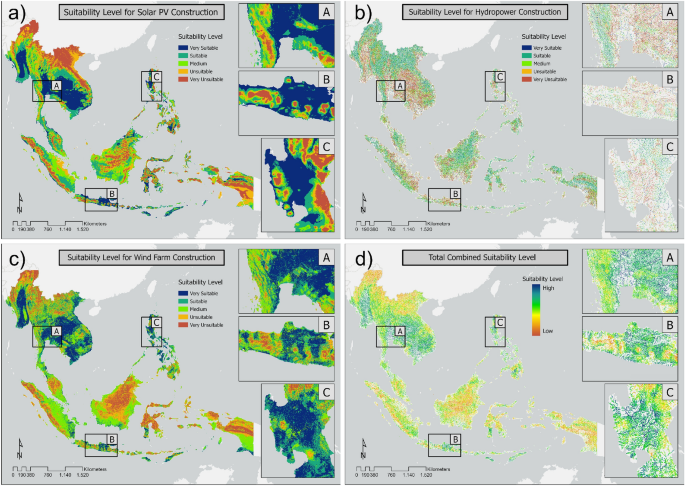
Levels of suitability for developing (a) solar photovoltaic (PV) energy, (b) hydropower, and (c) wind power infrastructure in Southeast Asia, and (d) the total combined suitability levels for all three types of power.
The suitability levels for wind energy development in Southeast Asia are shown in Fig. 2b. Some areas with a high level of suitability included the north-eastern region of Thailand, which is dominated by relatively flat agricultural land, and the islands of Sumba and Timor near the equator, where the geography is mostly vast vacant land with a gentle slope. Despite the Luzon and Visayas areas in the Philippines being relatively densely populated, their geographical conditions are flat and supported by good infrastructure access. Figure 2c shows the suitability level of hydropower energy for rivers in Southeast Asia. Generally, rivers with a high stream order had reasonably high suitability index values. In addition, river networks in mountainous and rural areas had reasonably high suitability index values compared to areas near the coast and urban regions. Indonesia had the most significant potential of all the studied countries, with approximately 493 km2 or 35.94% of its area being considered suitable or very suitable. The second most suitable country was Myanmar, which had an identified suitable area of 298 km2 (21.71%), followed by Laos and Vietnam, with suitable areas of 124 km2 (10.03%) and 117 km2 (9.16%), respectively. An integration process was carried out on the three suitability index results to determine the areas with the highest and lowest overall renewable energy suitability. Figure 2d shows the results of the overall suitability index analysis.
Solar, wind, and hydropower energy potential
The potential for adequate solar, wind, and hydropower over 12 months in Southeast Asia is shown in Fig. 3. Figure 3a shows the effective power potential of Southeast Asia’s solar panels, which was calculated by combining the conditions of solar irradiance and the effects of temperature, aerosol optical depth (AOD), and rain. The highest energy potential produced by solar panels occurred in October (21.386 GWp), whereas the lowest was in April (2.087 GWp). Figure 3b shows the wind energy potential for 12 months in Southeast Asia. The generated power varied each month and was mainly influenced by wind speed. The maximum power generated was 400 W/m2 in the highest class, assuming a wind height of 100 m. The processing results showed that the highest estimated power production occurred from June to August, whereas April and October had the lowest energy production. The estimated monthly energy produced from hydropower in Southeast Asia countries is shown in Fig. 3c. The figure shows the monthly pattern of estimated hydropower potential in the 12 month period of 2020. It can be seen that there are two different patterns in the northern countries of Southeast Asia, such as Myanmar, Vietnam, Thailand, Laos, Philippines, and Cambodia, compared to the southern parts, such as Indonesia, Malaysia, Brunei, Singapore, and Timor Leste.
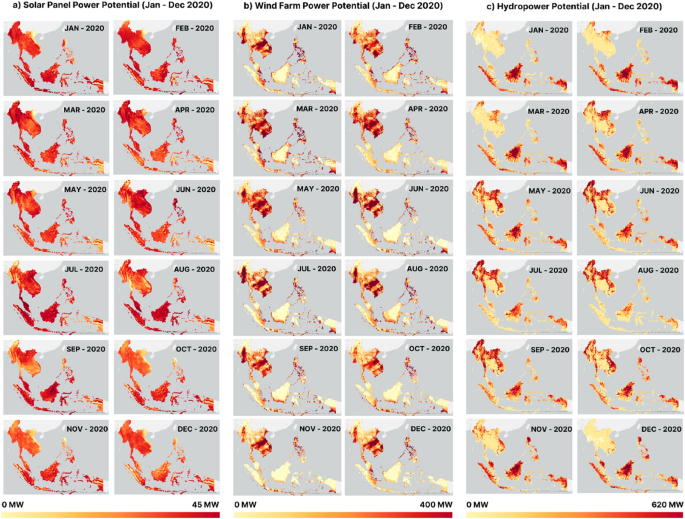
Map visualization of monthly power potential (January–December 2020) for (a) solar panels, (b) wind farms, and (c) hydropower.
A 12 months time-series graph of the potential solar, wind and hydro power in 11 countries in Southeast Asia is shown in Fig. 4. The countries with the highest potential solar PV power are Indonesia, the Philippines, Vietnam, Cambodia, Thailand, and Myanmar (Fig. 4a). For Indonesia, the graph shows that April to August had a downward trend with a considerable potential for solar panel power (approximately 70 MW), and the trend rose in September to reach the highest potential (94.346 MW). Vietnam, Cambodia, Thailand, and Myanmar showed nearly identical trends, where the lowest potential (approximately 60 MW) occurred in January, and the potential then increased from February to March. These four countries reached enormous power potential, with Vietnam reaching 85.779 MW, Cambodia reaching 82.879 MW, Thailand reaching 80.263 MW, and Myanmar reaching 75 MW. Countries with low potential were Timor Leste, Singapore, Laos, Malaysia, and Brunei. The trend in Timor Leste decreased and then increased, with the potential in January being 20 MW, rising to the highest potential of 39.924 MW in February, and then decreasing again in March to 22 MW. Singapore, Laos, Malaysia, and Brunei showed nearly the same trends. They had the lowest potential in January, then stabilized, decreased until August, and rose again in September.
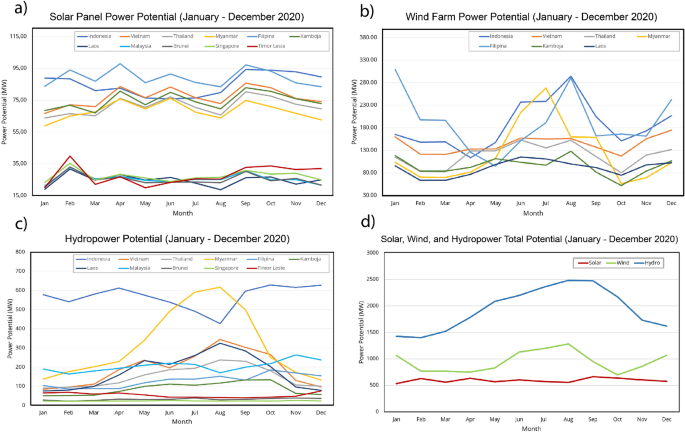
Country profile of monthly power potential from January to December 2020 for (a) solar photovoltaic (PV) power, (b) wind farms, (c) hydropower, and (d) the combined total for solar, wind, and hydropower in Southeast Asia.
Figure 4b shows a monthly time-series graph for seven countries based on the power potential analysis for wind farms. Similar to the solar PV power potential, these values were taken from the average of all rasters per country. The seven countries experienced peak power from July to August. The power then decreased slowly and tended to stabilize until April, and then began to rise again in May. The Philippines was the country with the highest initial power potential, with 308 MW in January. The power then decreased moderately to approximately 95 MW in May before rising slightly and reaching a peak of 291 MW in August. From this point forward, the potential power of the Philippines experienced a decline and remained stable until November, before experiencing another increase in December. Regarding the other countries with less initial generated power potential, Indonesia, Vietnam, Thailand, Myanmar, Cambodia, and Laos started the year at around 165 MW, 160 MW, 115 MW, 103 MW, 118 MW, and 96 MW, respectively. The graphs remained stable until April, then climbed steadily and peaked at just above 290 MW in August for Indonesia, 268 MW in July for Myanmar, and 152 MW for Thailand. The power of Vietnam, Cambodia, and Laos was relatively stable from February to April before experiencing a steady increase and then decrease from July to August.
Figure 4c shows the monthly time-series graph of the hydropower potential. In the period of June–August, countries in southern Southeast Asia experienced a decline, where August experienced the minimum of the potential hydropower value. Meanwhile, the opposite pattern was seen for countries in the north; from May to September, there was an increase, with the peak occurring in August. This unique pattern occurred due to differences in the rainfall phenomena that occur in Southeast Asia, which are not uniform for the eleven countries over each month. Indonesia is the leading country in terms of hydropower potential, where the peak reached 626 MW and the lowest value was 426 MW. The countries that have relatively low hydropower potential values are Singapore, Brunei, and Timor Leste, whose largest potential values are 26 MW, 38 MW, and 75 MW, respectively. Figure 4d shows the solar, wind, and hydropower accumulation total for the combination of all regions in Southeast Asia. Hydro has highest total accumulative value compared with wind and solar. August and September are the months where hydropower reaches its maximum energy potential, while wind power is highest in August and January. Cumulative solar PV power is relatively constant throughout the year and exhibits the lowest power potential compared to other renewable energy sources.
The combined results showed potential points for power plants of various scales. Figure 5 shows that hydropower plants on a small scale (micro, with an energy potential of 5–100 kW; mini, with an energy potential of 100–1000 kW; small, with an energy potential of 1000–25,000 kW; medium, with an energy potential of 25,000–100,000 kW; and large, with an energy potential of > 100,000 kW27) could be located in rivers with minor flow accumulation and stream order compared to medium- to large-scale power plants. Upstream rivers would be dominated by micro- and mini-scale power generation classes. In contrast, larger downstream rivers, such as the Mekong, which flows across Myanmar, Laos, Thailand, Cambodia, and Vietnam, would be dominated by medium and large power plants. Other large rivers, such as the Pahang River in Malaysia and the Indragiri River in Indonesia, are also included in the small and medium classes (micro, mini, small). Such rivers can have this designation because rivers with significant flow accumulation and stream order have a relatively large discharge value. However, with regard to the head parameter, upstream rivers have more potential because of their steep slopes. For all of the types of hydropower plants combined, Indonesia had 1897 possible optimal points, which was the highest number compared to the other countries (56.25% of all points). Cambodia had the next most potential optimal points with 345 (10.23%), then Myanmar with 329 (9.75%), and Laos with 245 (7.26%).
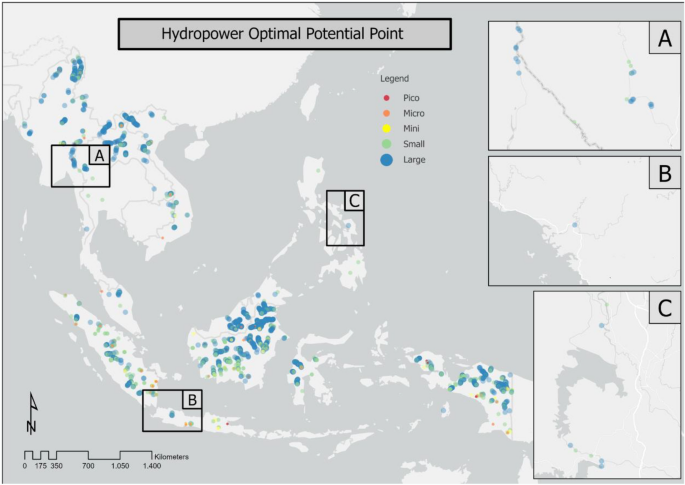
Potential optimal points for hydropower potential in Southeast Asia.
The annual generated power potential for multi-renewable energy construction of solar (Fig. 6a), wind (Fig. 6b), and hydropower (Fig. 6c) plants in Southeast Asia was also analyzed. The distribution of the potential energy value had different characteristics for each type of power plant. Therefore, a combined analysis of the power potential generated from the three sources of renewable energy was carried out to determine the total power potential in each area of Southeast Asia. Based on Fig. 6d, the areas with the highest combined power potential are mainly in northern Southeast Asia, including parts of Vietnam, Laos, Thailand, and the Philippines. Areas close to the equator, such as Indonesia, Malaysia, Brunei, and Singapore, have a lower potential than northern countries, except for southern West Nusa Tenggara (Indonesia) and Timor Leste. These results occurred because the potential for wind power is enormous in the northern area of the region, which leads to considerable differences in the combined power of the three energy sources.
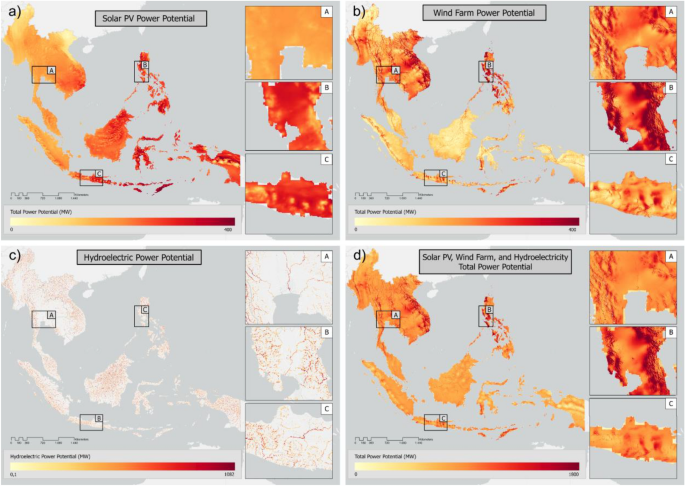
Power potential for (a) solar photovoltaic (PV), (b) wind, and (c) hydroelectric power, as well as the (d) total combination of the three types of power.
Multi-renewable energy in specific urban, rural, and agricultural areas
Figure 7 shows the dominance analysis of multi-renewable energy based on the potential power generated by solar panels, wind farms, and hydropower. This analysis was carried out by classifying the potential power into five classes and considering only the class with the greatest potential. The highest classes were then combined to determine the dominant areas for the construction of solar PV, wind, and hydropower plants, as well as their combinations. Overall, solar PV plant construction is the most area-intensive type of energy generation among the considered energy sources, requiring 143,901,600 ha (61.71%), followed by wind (39,618,300 ha; 16.98%); a combination of solar PV and wind (37,302,500 ha; 16%); hydro (7,665,200 ha; 3.28%); a combination of hydro and solar PV (3,792,500 ha; 1.62%); and a combination of hydro and wind (582,700 ha; 0.25%). Most of Indonesia’s territory is dominated by potential energy production via diesel, as are northern regions including Laos, Cambodia, and Thailand.
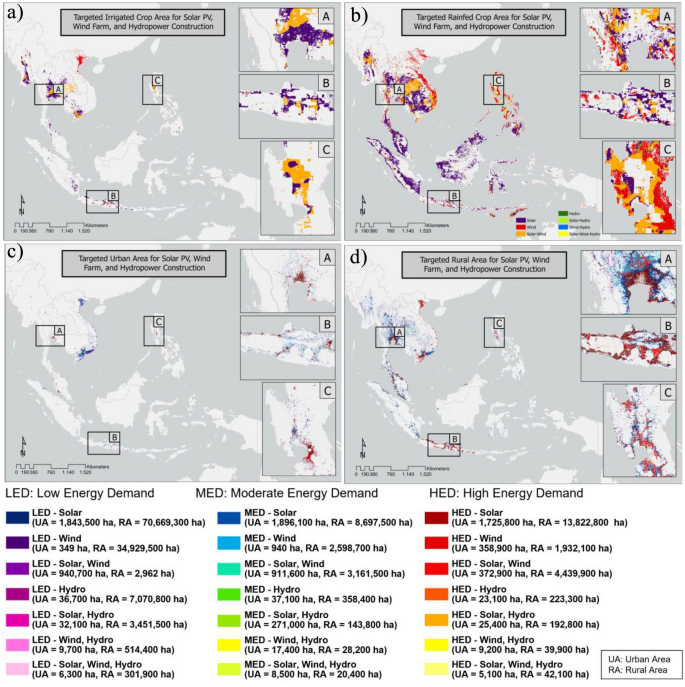
Demands for multi-renewable energy in (a) irrigated cropland, (b) rainfed cropland, (c) urban areas, and (d) rural areas in Southeast Asia. The total area of the three groups was calculated both for urban and rural areas.
There is ample wind potential in northern regions, such as the Philippines, Vietnam, Laos, and Thailand, and a combination of solar PV and wind farms is also dominant in these areas. For the three types of renewable energy combined, the areas with the greatest potential are parts of Vietnam and Laos, as well as the northern Philippines. In this study, the analysis of the dominance of multi-renewable energy was carried out for four specific target areas, namely irrigated agriculture, rainfed agriculture, urban areas, and rural areas, to identify the areas with the most potential for constructing renewable energy. The urban and rural areas were divided into three classes of energy demand: high (HED), moderate (MED), and low (LED). This was done by classifying the estimated urban and rural energy demand (Fig. 1) into three categories using the geometric interval method, and then overlaying these estimations with the three types of renewable energy. This classification process details the energy potential based on the characteristics of each region. An analysis of the agricultural area was conducted to determine the potential of renewable energy in supporting sustainable food security. For example, the water pumps used to irrigate agricultural areas are expected to be powered by renewable energy rather than fossil fuels in order to increase agricultural productivity. In urban areas, the massive energy demand can be addressed by utilizing environmentally friendly energy sources currently receiving public attention, such as through installing solar panels on the roofs of buildings. In urban and rural areas, it is possible to use the construction of solar panels, wind farms, and hydropower to achieve energy distribution, especially in areas that do not yet have electricity.
Figure 7a, b show the solar, wind, and hydroelectric energy demands for agricultural areas with irrigated and rain-fed crops. The rainfed area in Southeast Asia is larger than the irrigated crop area, meaning that rain-fed agricultural systems are dominant. Additionally, in rainfed crop areas, energy sources can also be used to assist pumping and irrigation processes, so that they do not rely solely on rain for irrigation. Irrigated agricultural land is dominated by solar and wind power potential. The areas with the highest probabilities of combined renewable energy are southern Myanmar, Thailand, and Vietnam. In the rainfed agricultural area, the potential for these three types of energy is equal. Most of Indonesia’s territory and northern countries such as Myanmar, Laos, Cambodia, Vietnam, and the Philippines are covered by areas with solar and hydro potential. There is also ample wind potential in northern countries, such as the Philippines, Vietnam, Laos, and Thailand, and it is possible that solar panels and wind farms could be combined in these areas. It is most likely for the three energies to be combined in the rainfed agricultural regions of Vietnam and Laos, as well as in the northern and southern parts of the Philippines. Figure 7c,d show the urban and rural areas for which the construction of solar panels, wind farms, and hydroelectric power plants could be targeted. Urban areas with the highest energy demand have the most solar potential, including Bangkok (Thailand), Hanoi (Vietnam), Manila (Philippines), and Jakarta (Indonesia).
It is recognised that the transition to renewable energies such as solar energy will intensify the global competition for land and drive land use change, resulting in further environmental impacts. Focusing on the EU, India, Japan, and South Korea, Van de Ven et al.28 found that solar energy may occupy as much as 5% of the total land area to produce 80% of the electricity in these areas by 2050. This land requirement is significant; for illustration, 4% of the land in the EU land is currently covered with manmade surfaces29. A solution to this problem is to integrate solar energy into urban spaces, for example, by placing small-scale PV systems on the roofs of buildings, even though the potential is somewhat limited; only around 3% of urbanized surfaces are suitable for such purposes with reasonable efficiences30. Urban areas typically have high energy needs31, and most of these areas are covered by solar potential. Solar PV installation on the rooftops of buildings has the potential to provide clean energy sources in urban areas. The deployment of rooftop solar PV has been increasing in recent years, especially with the increased interest in the net-zero energy building (NZEB) concept32. To achieve NZEB goals, buildings are expected to install sustainable energy sources such as rooftop PV systems, especially for commercial and high-end residential buildings33,34.
In rural areas with high energy demands, the three types of renewable energy are equally dominant. This is because constructing wind turbines with heights of 100 m requires a large area, and hydropower plants are constructed in existing river networks that are primarily found in rural areas. Rural areas with high energy demand due to a high concentration of industry are mainly found in Java (Indonesia), Brunei, Malaysia, southern Thailand, and northern Vietnam. In this analysis, three samples were taken from urban and rural areas based on the prominent differences in their energy demands and renewable energy potential. The three urban samples highlighted, namely Bangkok (Thailand), East Java (Indonesia), and Manila (Philippines), each have characteristics that are intermediate between urban and rural areas. Urban areas have high energy needs, and most of these areas are covered by solar potential.
Table 2 lists the area distribution for the potential of each type of energy and its combination in eight targeted areas. Physical characteristics and the energy demand are important factors that determine the type of energy that can support each targeted area. Overall, it can be seen that solar energy dominates the urban, rural, and agricultural regions. Urban areas that already have energy infrastructure based on fossil fuels are challenged with an energy crisis. Therefore, it is time to transition to alternative energy sources, and this can be achieved because, although the energy demand in urban areas is increasing, the supply of energy sources, such as solar power, is also very high. In addition to the potential of solar panels, the potential for wind power development is also high in MED and LED urban areas. With a large supply of energy sources, rural areas should be able to use energy that is not as widespread as in urban areas. The energy demand in rural areas is high, but there are still residential areas that do not have electricity. Rural areas therefore exhibit unique patterns based on their energy needs. The lower the energy demand in the area, which corresponds to lower population levels, the greater the potential for building wind and hydropower plants. This is especially the case considering that such facilities require a large land area and, in the case of wind farms, must be far from settlements, or in the case of hydropower plants, require a network of rivers with large discharges that can generate considerable power. As previously mentioned, an analysis of the agricultural area was conducted to determine the potential of renewable energy in supporting sustainable food security. The amount of diesel fuel used in agricultural areas supports the currently developing technology of agri-voltaic power, in which photovoltaic panels are placed above crops to increase agricultural productivity while reducing environmental impacts35. The likelihood of developing hydro and wind farms is greater in rain-fed agricultural areas than in irrigated areas. The three renewable energy sources involved in this study require suitable locations to produce large potential power generation and specific regions for their optimal utilization.
watch avatar the way of water full movie
watch avatar the way of water full movie
watch avatar the way of water full movie






